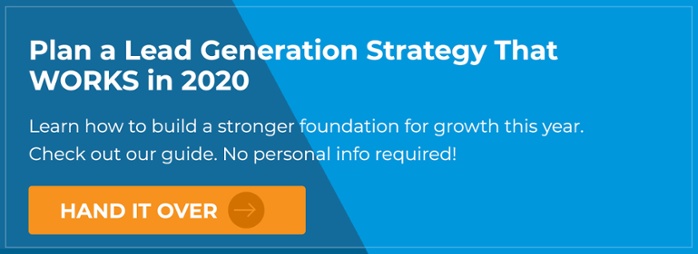
Healthcare Marketing Trends to Think About In 2020
Patrick Dodge
Founder
It's that time when healthcare companies are hatching their growth plans for the coming year.
The spotlight is on the marketing and sales teams as they draw up plans for attracting more prospects and closing new business. Creating a new growth strategy is not easy, especially given how fast marketing is changing.
In just a few years, we’ve gone from having too little data to work with to having too much. Managing it all can be more than a little overwhelming. As you think about your strategy, I would encourage you to think "high level" about your approach first before worrying about the tactics your team will execute, like blogging, social media, and advertising.
Here are just a few trends happening today you may want to consider.
Finding Your “Why”
Ever wonder why brands like Apple, Yeti, Southwest Airlines, and Patagonia get such unshakable loyalty from their customers?
Are their products that much better than the competition? Is it just clever marketing and a keen knowledge of the lifestyle their customers identify with?
The answer is yes and no. Yes, their products are high quality and their marketing is well executed, but thousands of companies can make the same claim. So, why are the above brands seen as innovators year after year, product after product?
It’s because they focus on WHY they do what they do, and live that purpose in their work.
Simon Sinek explains this beautifully in his book, Start With Why. While other brands try to differentiate themselves by explaining WHAT they do and HOW they do it, true innovators have a clear sense of purpose that strikes deep into the values of their customers.
In the words of Brian Halligan of HubSpot, “HOW they sell is WHY they win.”

These brands will never rely on promotions, incentives, discounts, or any form of manipulative marketing to grow. They just have to live their purpose, stay loyal to their tribe, and deliver quality products.
I can’t think of any industry in America that’s starving for brands with a purpose more than healthcare.
Whether you specialize in helping providers manage data better, improve compliance, maximize patient outcomes – you have a calling that has a deep impact on the people you serve.
If your management team does nothing else to prepare for growth in 2020, they should look above the nuts and bolts of WHAT you do and HOW…and find your WHY.
Redefining Your Content Marketing Strategy
Eight out of ten people reading this post are managing a blog, shooting videos, or producing some form of content on their websites in hopes of attracting and engaging new customers.
But how many of you know how it’s translating into ROI? If you aren’t sure it’s time to change that. Here are a few considerations:
1. Account-based marketing or inbound?
Account-based marketing is a “new-ish” trend where companies are monitoring, targeting, engaging, and closing a select group of accounts that meet their ideal buyer profile.
Instead of attracting and converting all prospects for your products and services, ABM focuses your sales and marketing efforts on hyper-personalized experiences targeted at accounts that would make the best-fit customers (most profitable and highest satisfaction scores).
Inbound marketing, by contrast, is about aligning your content strategy with the context of the buyer, helping them solve challenges and nurturing them with valuable content until they are ready to buy.
There are similarities between the two approaches are somewhat similar, and both are highly effective. Evaluating what’s best for your brand really comes down to one question: Is targeting only the best accounts the most efficient approach, or do you need to cast a wider net?
2. How well do you really know your buyer personas?
A great content strategy comes good persona research, and unfortunately, most companies base their buyer personas on guesswork. They talk to a few clients, ask the sales team for a few insights, or just sit around the table speculating about what’s important to buyers. This does not give you real insight into how people make buying decisions.

Try finding 10 people who have evaluated a solution like yours in the last year (not people who currently do business with you), and interview them about what was important to them throughout the process.
Here are the questions to ask them: Buyer Persona Examples
3. Have you invested in a marketing automation platform?
If your company is not using an automation tool like HubSpot or Marketo to manage your sales and marketing efforts in one place and channel data to your CRM, you are making it much harder to maximize ROI.
There’s nothing wrong with using single-purpose apps like MailChimp, Buffer, Hootsuite, WordPress and others, but it’s difficult to create a unified view of your campaign and tie it back to dollars and cents. HubSpot helps you monitor user behavior on your website, personalize their experiences, and track their progress throughout the buyer’s journey, and set appointments for sales calls.
If you want real traction with your provider accounts, you need real insights into what they are responding to. Marketing automation will help you do that.
Related Article: Comparing Marketing Automation Tools
Improving the Customer Experience
The marketing community is waking up to a sad realization: most companies give customers only fraction of the care and attention they got when they were prospects.
There’s a huge disparity between how companies perceive the quality of their service, and what their customers think.
But this challenge goes way beyond service. Building a great customer experience means anticipating challenges your clients have before they happen and replacing them with pleasant, memorable experiences.
Everyone wants more word-of-mouth sales. Creating an unbeatable CX is the only way to get them. Here are some areas to focus on:
On-boarding
Does your team communicate and manage the onboarding process in ways clients can easily understand and digest?
Just because your solution was important enough to invest in doesn’t mean it will be at the top of your new partner’s priority list when you get started.
Finding a creative, visual way to document the process and collect any needed information from them can go a long way toward tamping down buyer’s remorse and boosting confidence in your team. Try sending video updates, or better yet, send a glossy calendar with the stages of implementation outlined for them. This is much better than sending emails. Who needs more of that? Ugh!
Acclimation
After on-boarding is complete, your team is likely busy helping them get acquainted with using your tools.
Lab testing, digital trials, EHR, and other business intelligence solutions all require a ramp up time that’s critical for client success. This is where your organizational WHY starts to take shape in the mind of the customer, as well as the HOW.
The key here is to identify points of friction customers struggle with and disrupt it. If your solution involves training, what areas do most clients struggle with? Don’t just send them links to your knowledge center. Make your account manager pick up the phone and call the client. Ask how they are doing, answer questions, and schedule follow up sessions to help them.
Making your clients serve themselves every time they need help will lead to only one thing – you searching for new clients.
Read More: Want to Build a Great Customer Experience?
Most Importantly, Focus On Humanizing Your Brand

As I mentioned earlier, it’s not productive to worry about new tactics to healthcare marketing. There will always be a shiny new toy for marketers to run toward.
Whatever you do, make certain you aren’t over-automating interactions with your customers, especially emails and chatbots. Your tech tools should accelerate the process of connecting with your clients on a human-to-human level, not put automated barriers that frustrate the process.
By establishing WHY your company serves healthcare providers -- and creating a great content strategy and customer experience around it -- you will be way ahead of your competitors.
There’s not a doubt in my mind.
Oct 25, 2019 2:47:41 PM
